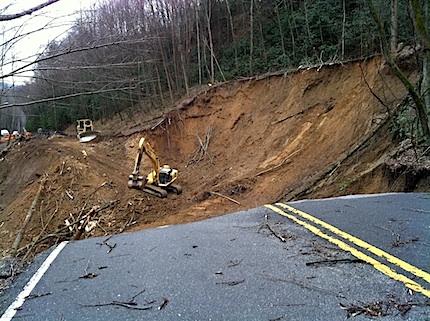Though the recent Jan. 16 landslide destroyed nearly 200 feet of Newfound Gap Road (U.S. 441), most park activities and destinations remain open and accessible to visitors.
This according to officials with the park who said some roads are still being cleared on the Tennessee side due to debris from recent storms, “but as far as Newfound Gap, you can access all the hiking trails around there, and everything that’s normally open along that road. It’s just that small section past Newfound Gap Road, just a little past the parking lot, that’s closed.”
So campgrounds, trails and picnic areas, as well as popular destinations like Cades Cove and the views at Newfound Gap near the border, are still open, and everything will stay open barring inclement weather.
Basically, the only thing visitors can’t do is get to Cherokee, N.C., via Newfound Gap Road. That, and they also can’t see the landslide, though several people at the Sugarlands Visitor Center had come to the park Thursday for that reason.
Many have come to the park specifically to see the landslide and just pass the time for curiosity’s sake. But, unfortunately, those people are being turned away from that specific area of Newfound Gap Road. National park officials have said that no one would be allowed to see the landslide for themselves.
Of course, January and February are lower-visitation months for the park, so the indefinite closure won’t affect tourism as much as it could have.
Still, the park is doing whatever it can to spread word that most of its attractions are still open.
“I’ve had people stop in and think they couldn’t get past Sugarlands, but that’s incorrect,” on park official said. “There are some people coming in, but I hope to get the word out that there is still access further into the park.”
They said there’s still no timeline for when the park reopens the closed portion of Newfound Gap Road, and as far as the trails on that portion, officials are assessing the situation.
“We’re looking at what impact it has on the trails and finalizing ideas on what we could do to have access on those trails or educate people about what’s going to happen until the road’s completely fixed.”
